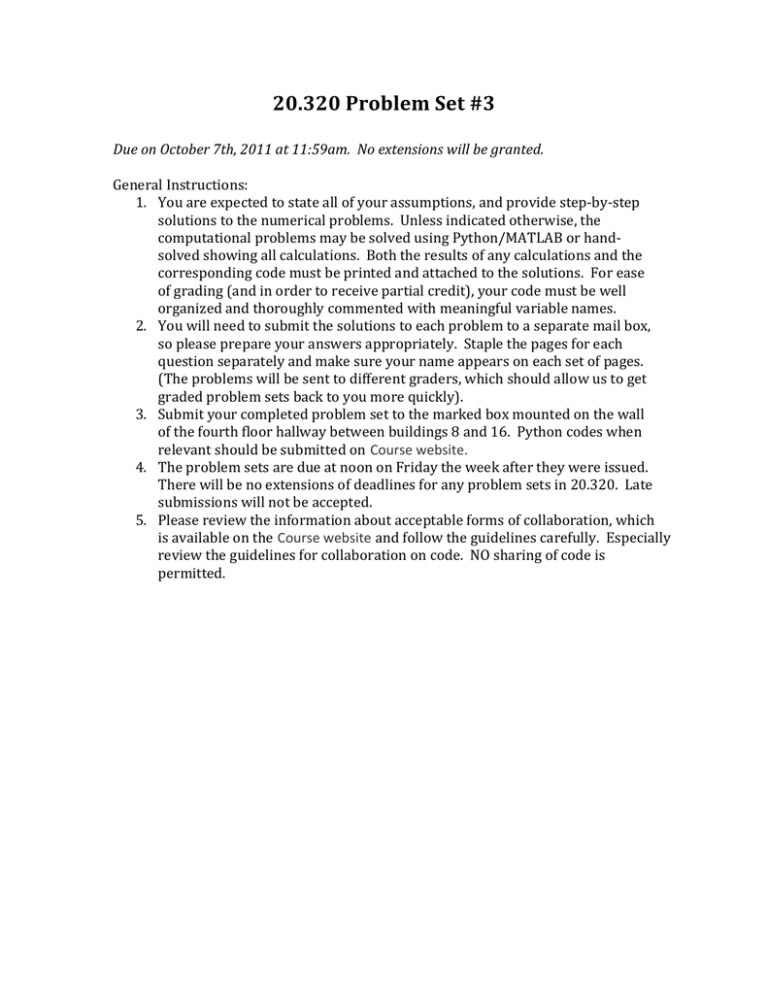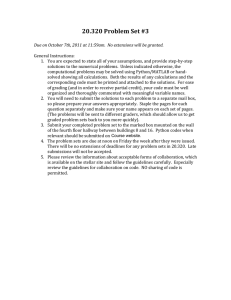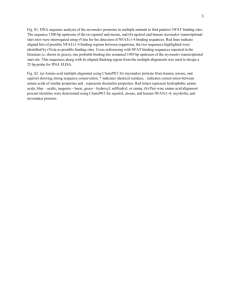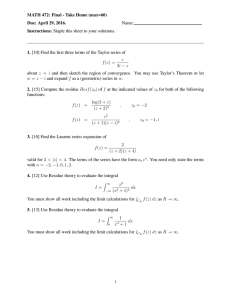20.320 Problem Set #3
advertisement

20.320 Problem Set #3 Due on October 7th, 2011 at 11:59am. No extensions will be granted. General Instructions: 1. You are expected to state all of your assumptions, and provide step-by-step solutions to the numerical problems. Unless indicated otherwise, the computational problems may be solved using Python/MATLAB or handsolved showing all calculations. Both the results of any calculations and the corresponding code must be printed and attached to the solutions. For ease of grading (and in order to receive partial credit), your code must be well organized and thoroughly commented with meaningful variable names. 2. You will need to submit the solutions to each problem to a separate mail box, so please prepare your answers appropriately. Staple the pages for each question separately and make sure your name appears on each set of pages. (The problems will be sent to different graders, which should allow us to get graded problem sets back to you more quickly). 3. Submit your completed problem set to the marked box mounted on the wall of the fourth floor hallway between buildings 8 and 16. Python codes when relevant should be submitted on Course website. 4. The problem sets are due at noon on Friday the week after they were issued. There will be no extensions of deadlines for any problem sets in 20.320. Late submissions will not be accepted. 5. Please review the information about acceptable forms of collaboration, which is available on the Course website and follow the guidelines carefully. Especially review the guidelines for collaboration on code. NO sharing of code is permitted. 20.320 HW#3 Specificity, Mutagenesis and MSA Fall 2011 Problem 1 - bZIP specificity (20 points) Amy Keating gave a guest presentation about optimizing binding for bZIP using protein binding arrays. Their group used protein binding assays to identify fragments that would optimally bind bZIP in a selective manner. A. What is bZIP? Why was it important to design peptides that would bind this molecule and what biological goal were they approaching by optimizing for this binding event? (4 points) bZ/P is a transcription factor, they were trying to optimize peptides that would beind this transcription factor and act as a "sink" to prevent bZ/P from activating its normal transcriptional profile. B. What are the four types of natural specificity that Professor Keating mentioned in lecture? These were the four ways that she mentioned the cell could control protein binding interactions. (4 points) spatial localization, temporal localization, scaffolding, structure C. Generally explain their peptide array approach - how does it find optimal binding partners? What do you measure in the experiment? What results came out of their approach? (4 points) /n the peptide binding array, you fix short amino acid sequences to a glass cover slip and expose to purified bZ/P protein. The assay uses a fluorescent reporter to identify strong binders and thus you quantify florescence for each binding pair. The results are a high-throughput set of "interaction" profiles which detail the fragments that bind most strongly to bZ/P. D. What was their rationale for using a computational approach to also predict protein specificity? What factors was the computational approach able to reveal about bZIP specificity? (4 points) They rationalized the computational approach with the idea that each amino acid could be given a score in the binding site and that with computation, they could predict which fragments were responsible for binding. They found that only a few amino acids in the active binding site were responsible for bZ/P's binding specificity. E. Explain the tradeoff between specificity and stability. Conceptually, how did their CLASSY algorithm deal with this trade-off? (4 points) Stability requires that your designed peptide form a stable complex with the target and specificity requires that your peptide interacts with your target better than competing targets. CLASSY tried to optimize the change in free energy associated with binding while simultaneously trying to maintain an energy differential between their engineered peptide and other competitors. 2 20.320 HW#3 Specificity, Mutagenesis and MSA Fall 2011 Problem 2 - Thermodynamic Cycles and Alanine Scanning (16 points) In class we talked about re-designing GCSF as a potential therapeutic. Optimizing specificity of interaction is one part of that task, but before we can start designing, it's important to characterize how the natural molecule binds and how residues in the protein's amino acid sequence contribute to the molecule's natural binding. As such, we'll use alanine scanning and thermodynamic cycles to look at the interaction. A. Draw out the four thermodynamic cycles for different GCSF mutants binding to the wild-type receptor. Be sure to label the ligand and receptors along with each ΔG correctly. (4 points) B. Compute the ΔΔG between all mutant pairs. Just calculate the free energy of mutation in the background of the wild-type receptor. (6 total ΔΔG's) at normal body conditions (37° C and 1 atm pressure). (4 points) LLG represents the difference in binding energies when comparing two different mutants of a 3 20.320 HW#3 Specificity, Mutagenesis and MSA Fall 2011 ligand or a receptor. To compute a LLG, we simply compute each individual LG and subtract them. Recall that LG = RT lnKd . To calculate the LLG comparing the free energies of binding GR to the E19A and K23A mutants of GCSF: ΔΔG°K23A–E19A = ΔG°GR−K23A − ΔG°GR−E19A = - 0.00199 kcal ( mol−K)(310 K) ln 0.077 ×10[ = -0.266 kcal/mol ( −9 ] M)− ln(0.050 ×10−9 M) Similarly, for comparing other pairs of mutant GCSF: ΔΔG°E46A–E19A = -0.258 kcal/Mol ΔΔG°D112A–E19A = -0.112 kcal/mol ΔΔG°E46A–K23A = 0.00806 kcal/mol ΔΔG°D112A–K23A = 0.154 kcal/mol ΔΔG°D112A–E46A = 0.146 kcal/mol C. Given these ΔΔG's, which mutations destabilize binding to the wild-type receptor? Consider what these mutated residues may have been contributing to the protein before being switched to an alanine (4 points) Given these calculations it appears that the K32A and E19A combination and the E46A and E19A mutations are the least favorable for the protein. /t appears that the glutamic acid at position 19 is important for binding, possibly through a charge-charge interaction. D. Suppose we want to look at the WT and E46A GCSF variants with WT-GR and R288A-GR. Draw out the double mutant cycle. Be sure to label the ligand and receptors along with the ΔG's and ΔΔG's correctly. (note: you can draw it as a cube, or simplify it, but it must contain all of the components). (4 points) GCSFWT GCSFWT-­‐GRR288A ΔGmut-­‐bind,WT ΔGWT/E46A, unbound ΔGWT/E46A, mut-­‐bind ΔGmut-­‐bind, E46A GCSFE46A GCSFE46A-­‐GRr288A 4 20.320 HW#3 Specificity, Mutagenesis and MSA Fall 2011 Problem 3 - Rotamer Packing (55 points) In the previous problem we looked at using thermodynamic cycles to analyze how changing multiple residues to alanine affected binding of the growth factor to the receptor. Now we will use an energy minimization algorithm to perform a rotamer search to repack the side-chains of the GCSF/GCSF complex into a new, relatively low-energy state after mutating. This time we will be mutating the aspartic acid at residue 110 to a histidine. A. In order to make the calculations manageable we will only mutate single amino acids - such as mutating Asp110 -> His110. Briefly discuss the implications of mutating a single residue on: a. Overall protein structure b. Backbone conformation c. Protein packing d. Protein Binding (take a look at 1CD9 AB.pdb for this one). (5 points) One of the key assumptions in mutating a single residue is that the secondary and tertiary structures do not change much, and that the backbone conformation isn't greatly affected. Since this specific mutation is not involved in a hydrophobic core, it won't affect protein packing, but it will likely affect the protein's ability to bind the receptor. B. Download pdb files 1CD9 A.pdb and 1CD9 AB.pdb from Course website. These files contain the structure of the unbound GCSF protein and the structure of GCSF and the extracellular portion of the GCSF receptor, respectively. Look at both structures in PyMol. Attach pictures of the structures with the aspartic acid high-lighted in a different color than the rest of the protein. Given the discussion in class what can you say about how Asp contributes to binding affinity vs binding specificity in this interaction? Why? (7 points) Since charged residues have to give up favorable interactions with the solvent (i.e. undergo exchange reactions), it's less likely that they are contributing to the affinity of binding. More likely they are contributing to the specificity of 5 20.320 HW#3 Specificity, Mutagenesis and MSA Fall 2011 binding. C. The interaction energies of these particular side chains depend on their orientation. Different side-chain "packing" leads to the development of different rotamers - each that have different energies of folding. PyRosetta can help us look at how different iterations of folding/packing residues on the protein can change the energy. The program optimizes new folding through a Monte-Carlo algorithm (the details of the algorithm aren't important, just know that it will help you optimize rotamer packing). For this problem you are going to repack residue 110 and look at how the energy changes. /ntro from PyRosetta's tutorials: (Oust for reference) Rosetta has a side-chain repacking routine pre-packaged as a "mover", which carries out a computational search each time it is applied. The specific scope of the packing is specified in a PackerTask object, which we can specify via commands or from an input file. Useful PyRosetta commands: (These you will need to know) Create a PackerTask as follows. This will set the task to allow packing only of residue 49: task task task task pack = standard packer task(pose) pack.restrict to repacking() pack.temporarily fix everything() pack.temporarily set pack residue(49,True) Confirm your settings using: print task pack We now can create a PackRotamersMover: packmover = PackRotamersMover(scorefxn,task pack) Apply the packmover to your pose with: packmover.apply(pose) For this problem you are going to repack residue 110 and look at how the energy changes. Familiarize yourself with the new PyRosetta commands and then write a python script to use PyRosetta to repack residue 110 of the 1CD9 A.pdb file. Because repacking is a stochastic process, write your script such that it will repack the residue 10 times and take the average of all ten scores. What is the score before and after packing? Has it changed significantly? How can you explain the change/no-change in the two scores? 6 20.320 HW#3 Specificity, Mutagenesis and MSA Fall 2011 (15 points) The score before packing is -61.337 and the score after packing is -61.530. The score hasn't changed much and this is likely due to the fact that the protein already has an optimal orientation for ASP110 or the fact that a charged, relatively large residue has a limited acceptable rotational space to search over. D. Mutagenesis: We can now follow a similar analysis after mutating residue 110 from Asp to His. Again, PyRosetta can help us do this, this time using their Design capabilities. Design operations are easiest to specify through a data file called a "resfile." You can create a resfile for a given pdb file or pose using: generate resfile from pdb("1CD9 A.clean.pdb","1CD9 A.resfile") OR generate resfile from pose(pose,"1CD9 A.resfile") Inside the resfile you will see a list of all residues and NATRO next to it, indicating that it is set to use the native rotamer. NATRO can be changed to the following: NATRO NATAA PIKAA ILV ALLAA use native amino acid and native rotamer (does not repack) use native amino acid, but allow repacking to other rotamers use only the following amino acids and allow repacking between them use all amino acids and all repacking Edit the resfile to allow force residue 110 to be Histidine ("110 A PIKAA H") and save the file as "1CD9 A-D110H.resfile". Create a new task for design from the resfile: task design = TaskFactory.create packer task(pose) **** note that this method has changed names recently and may be mis-documented on the PyRosetta site! task design.read resfile("1CD9 A-D110H.resfile ") Create a new PackResiduesMover packmover2 = PackRotamersMover(scorefxn, task design) with the design task and use it to mutate residue 110 to histidine. What is the new score? (Again, write a script to repack 10 times and find the average score). Is the mutation more or less stable? Discuss why histidine may be more or less stable for the protein. (15 points) The new score after mutating is 22.967 and this mutation is unfavorable for the protein. /t's like that since histidine is also a large residue, that there are steric 7 20.320 HW#3 Specificity, Mutagenesis and MSA Fall 2011 clashes between it and neighboring residues. Also, since histidine is negatively charged, you are likely losing the favorable contribution to specificity from the negative charge of Asp. Changing to a positive charge more generally affects charge-charge interactions. E. Hypothesize a side chain substitution that would be more favorable for the protein. State which residue you are selecting, and why you think it might be more favorable. (3 points) / would postulate that glutamic acid would likely result in a similar energy for the protein because it will still be able to form the same favorable charge interactions. The answers here are going to vary, but as long as they justify their residue selection based on the biochemistry, most answers are acceptable. F. Now change that residue using the same steps from part D. and report the new energy of the protein. Did the energy increase or decrease? Is this what you expected? Discuss why your residue selection may have increased or decreased the energy of the protein. (10 points) The switch to glutamic acid was more favorable than the switch to histidine but wasn't as energetically favorable as / had predicted. The new score after repacking was -45.054. / expect that the negative charge made it more favorable but because glutamic acid is larger than aspartic acid, it likely encountered steric hinderance of some kind. The answers are again going to vary here, but look to see that they answered all parts of the question and rationalized their findings. 8 20.320 HW#3 Specificity, Mutagenesis and MSA Fall 2011 Problem 4 - Multiple Sequence Alignment (9 Points) Receptor tyrosine kinases of the Epidermal Growth Factor (EGFR) family are essential to numerous physiological and pathological processes. In humans, 12 EGFR family ligands have been identified and a significantly conserved section of the multiple sequence alignment (MSA) of some members of this family is shown below. We have also included the extracellular matrix protein Tenascin-C which contains EGF-like domains known to activate EGF receptors. Some gaps have been omitted to simplify the problem. In the MSA, the amino acids are represented by their oneletter amino acid code. Capital letters indicate a significant alignment while lowercase letters indicate no significant alignment. AREG_HUMAN/142-182 BTC_HUMAN/65-105 EGF_HUMAN/972-1013 EREG_HUMAN/64-104 HBEGF_HUMAN/104-144 NRG1_HUMAN/178-222 NRG2_HUMAN/341-382 NRG3_HUMAN/286-329 NRG4_HUMAN/5-46 TGFA_HUMAN/43-83 TENA_HUMAN/559-590 KKNPCNaefqNFCIH-GECKYIEH---LEAVTCKCQQEYFGERCG HFSRCPkqykHYCIK-GRCRFVVA---EQTPSCVCDEGYIGARCE SDSECPlshdGYCLHDGVCMYIEA---LDKYACNCVVGYIGERCQ SITKCSsdmnGYCLH-GQCIYLVD---MSQNYCRCEVGYTGVRCE KRDPCLrkykDFCIH-GECKYVKE---LRAPSCICHPGYHGERCH HLVKCAekekTFCVNGGECFMVKDlsnPSRYLCKCQPGFTGARCT HARKCNetakSYCVNGGVCYYIEG---INQLSCKCPNGFFGQRCL HFKPCRdkdlAYCLNDGECFVIETl-tGSHKHCRCKEGYQGVRCD HEEPCGpshkSFCLNGGLCYVIPT---IPSPFCRCVENYTGARCE HFNDCPdshtQFCFH-GTCRFLVQ---EDKPACVCHSGYVGARCE KEQRCP----SDCHGQGRCVDG---------QCICHEGFTGLDCG A. Complete the PROSITE consensus pattern for the above alignment by manual pattern recognition of the MSA. If you are not familiar with PROSITE notation: http://en.wikipedia.org/wiki/Sequence motif. (1 point) x(4)- -x(3,7)- -x(4,5)-C-x(4,13)-C-x(1)-C-x(2)-[ ]-[F,Y]-x(4)- -x(1) x(4)-C-x(3,7)-C-x(4,5)-C-x(4,13)-C-x(1)-C-x(2)-[E,G,NJ-[F,YJ-x(4)-C-x(1) B. What amino acids were absolutely preserved throughout the evolution of this family? Give a rationale why each was preserved. (2 points) Cysteins: crucial for protein folding and forming intra-molecular disulfide bonds that are the base of the EGF-like ligands Glycine: Compact, small volume, good for packing C. What amino acids were somewhat preserved? Or which amino acids could be mutated to another amino acid with similar properties? (2 points) Tyrosine/Phenylalanine: with high contact surfaces, they are both generally abundant in protein-protein interfaces. Arginine: Positively charged side chain could be important for hydrogen bonding and hence for protein function. D. Compute the log-likelihood matrix for the first five positions of this alignment (use base 2 this time). Assume that all amino acids are equally probable in the background and add a pseudocount of 0.1% (4 points) 9 20.320 HW#3 Specificity, Mutagenesis and MSA Fall 2011 E. 10 MIT OpenCourseWare http://ocw.mit.edu 20.320 Analysis of Biomolecular and Cellular Systems Fall 2012 For information about citing these materials or our Terms of Use, visit: http://ocw.mit.edu/terms.





